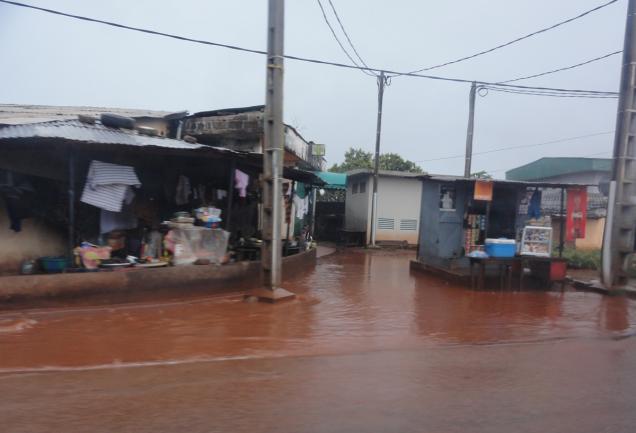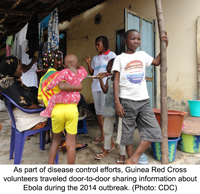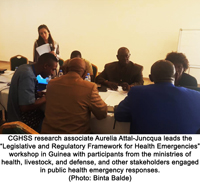Georgetown Researchers Weigh Lessons from Ebola Response in Guinea

Posted in GUMC Stories | Tagged Ebola, global health
January 4, 2018 — By spring of 2015, the Ebola epidemic was expected to be over in Guinea — a closed albeit tragic chapter for a disease-ravaged corner of the African continent.
At least that’s what Georgetown researchers anticipated when they were awarded a cooperative agreement from the U.S. Centers for Disease Control and Prevention (CDC) in 2015 to embark on post-outbreak recovery and rebuilding efforts in that West African nation.
Under the leadership of principal investigator Rebecca Katz, PhD, MPH, a team of global health experts was set to work with local health and regulatory officials to assess the country’s health system’s emergency management infrastructure and workforce capacity in the aftermath of Ebola. The work, which began when the team was at George Washington University, is now under the umbrella of Georgetown University Medical Center’s Center for Global Health Science and Security (CGHSS).
Pressing Priority
Yet even before their first visit to the country’s capital, Conakry, in April 2015, it was clear that the epidemic was far from over, and that containing Ebola’s transmission was still very much an active challenge in the country. While the major thrust of the epidemic was largely over, individual cases were still occurring.

Facing an urgent need to support the government’s Ebola response efforts, the team worked with the CDC and the Ministry of Health to adapt their original plans to conduct post-outbreak recovery — instead turning to confront the more pressing priority.
“It was a very dynamic situation on the ground there as they were trying to get the outbreak under control,” says Claire Standley, PhD, MSc, assistant research professor within CGHSS and technical lead for the work in Guinea. “We found ourselves trying to do capacity building in the midst of an active outbreak.”
“While we had laid out the best ways we thought we could support CDC and the Government of Guinea in their efforts to recover from Ebola and rebuild the health system, our plans had to change to support the ongoing outbreak, including working on active surveillance,” adds Katz, who is co-director of CGHSS.
Daunting Challenges
Weather can add another layer of complexity. In later visits during Guinea’s rainy season, which typically runs from June through September, the team quickly learned how rain can overwhelm the country’s infrastructure, including roads, thus further crippling Ebola response efforts by impeding transportation and logistics.
“In the capital, Conakry, gaping potholes appear each year and defy repair efforts during the drier months. Elsewhere in the country, where only the main arteries are tarmacked, roads can degrade into impassable mud streams for weeks at a time. These conditions contributed to the severe logistical challenges faced during the Ebola outbreak response, and go some way to explaining the persistence of the virus,” says Standley.
Building Capacity in Guinea
Within a few months, with the worst of the epidemic over, the team was able to shift its focus back to public health emergency management planning, laboratory systems strengthening and zoonotic (diseases that are transmitted from animals to humans) systems assessment.

The Georgetown team, including CGHSS co-director Julie Fischer, PhD, Erin Sorrell, PhD, Nina Kanakarajavelu, MPH, and Aurelia Attal-Juncqua, MSc, also continued ongoing efforts to supporting the development and strengthening of a network of subnational emergency operations centers (EOCs), which serve as the hubs for collaboration and communication during a public health emergency.
Working alongside the ANSS (Agence National de Sécurité Sanitaire) within the Ministry of Health, the idea was to evaluate the existing capacity and infrastructure to identify any critical gaps in responding to such emergencies.
Over the course of the project, the team also worked with the Ministry of Health on a variety of activities geared to strengthen Guinea’s capacity to confront a health crisis. These included supporting the creation of a national specimen referral policy, supporting the World Health Organization’s Joint External Evaluation mission, and supporting the ANSS in operationalizing the national public health EOC.
“We currently have a consultant embedded with the EOC team in Conakry, helping them draft core operational and strategic documents. The consultant is actually from the EOC in Côte d’Ivoire, so it’s also an opportunity to build regional relationships and share lessons learned,” Katz says.
Creating Lasting Impact
As funding for the project draws to a close next month, Katz, Standley and the rest of the project team, including two full-time consultants in Guinea, are assessing their successes and lessons learned as they seek to report on their findings.
The Guinean government is better equipped to respond to a health crisis now that clear response protocols and training templates are being put in place to ensure the EOCs can function the way they need to. The new national specimen referral system, linked to Guinea’s laboratory network, will hopefully allow for quicker identification of any future outbreaks.
Overall, the experience underscores the vital importance of tight collaboration among international and national partners working in a health crisis situation, the researchers say.
“Within the context of the Ebola response, things were frantic. There were so many partners doing different things and trying to plug holes in the dam,” Standley says. “Everyone was doing the best they can. A bit more foresight would have been beneficial, but people were prevented from having that foresight due to the quickly evolving nature of the response.”
And the experience in Guinea has already led to tighter coordination among the government and CDC-funded partners working there. There have now been three meetings — spearheaded by Georgetown and the nonprofit research institute RTI International — to coordinate efforts and strengthen collaboration among partners funded by CDC, and to align activities with the priorities of the Guinean government.
Prevent, Detect and Respond
Katz is quick to acknowledge that front-line health care workers are the “true heroes” of the Ebola outbreak in that they put their lives on the line to treat the people affected by the disease.
But she stresses that a critical part of the puzzle in preventing the next health crisis is to fix broken systems and build capacity where it currently doesn’t exist. In this sense, she says, academic institutions such as Georgetown have a key role to play in translating academic literature into practice and, in turn, policy to support governments in these efforts.
“There is a vital role for academia. We have a significant amount of literature on these topics — the challenge is translating this research into practice. That’s the space we have been operating in.”
She and Standley are hopeful that the Guinea experience can provide helpful insights to guide public health emergency response efforts elsewhere in the world.
“We want to support efforts to build capacity in every corner of the world to be able to prevent, detect and respond to disease. If you can contain an outbreak at the source, it won’t spread around the world — and lives will be saved,” Katz says.
Lauren Wolkoff
GUMC Communications
